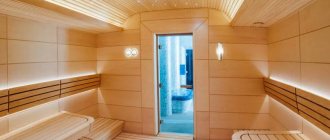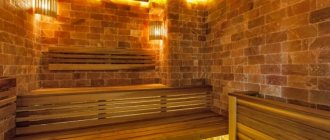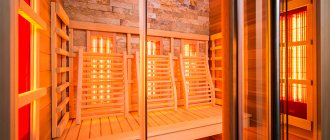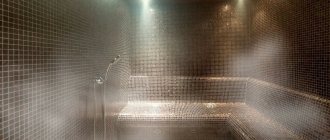Is it possible to go to the bathhouse (sauna) after training?
Sauna is a modern derivative of the traditional and familiar bathhouse, which has long been famous for its ability to have a beneficial effect on human health. Visiting the sauna after training has become especially popular recently, although this issue is very controversial. Of course, after heavy exercise and working on your body, going and relaxing in the sauna is what you need, especially since almost every large gym has its own sauna.
The effect of a sauna is not only a good mood and a feeling of relaxation, but also an internal effect on the body that cannot be noticed just by looking at a person. Therefore, we will describe the effect that a sauna has on the human body immediately after a workout:
- After visiting the sauna, the muscles are renewed twice as fast, due to the fact that the blood vessels, due to the increase in temperature, become more elastic and wider, which makes the heart more active;
- In North America, a study was conducted by regular sauna clients, during which it was proven that a session in the steam room of a gym visit not only relaxes, but also reduces muscle pain due to the fact that endorphin, the hormone of happiness, is actively released. The same experiment also proved that visiting a sauna helps get rid of lactic acid lactate and toxins that are released in the body during training and “slow down” muscle function;
- The sauna promotes comprehensive cleansing of the body: from toxins in the body to pores on the skin, and this is very important for those who train constantly;
- During training, the hormone cartisol is released, which destroys the body. The sauna helps get rid of it;
- The sauna is an excellent solution for those who are overweight and are trying to get rid of it through training and exercise training. The sauna will be a good helper in this matter, because it has been proven that in half an hour you can lose 300 calories here. In addition, under the influence of high temperature, which evenly warms the body, metabolic processes in the body and chemical reactions are accelerated and subcutaneous fat, which often turns into an “orange peel”, disappears faster. As for visceral fat, it is often quite difficult to track its appearance. When stressed, it leaves along with the subcutaneous fluid, so visiting the sauna will help in this case too.
Background
Playing sports and a healthy lifestyle are not a newfangled trend, as many people think. Even in ancient Rome, the cult of a healthy body, as well as a steam bath, was revered. Not only did the Romans engage in sports, but there were thermal baths everywhere - analogues of modern saunas. The most popular types at that time were strength exercises, from which athletics, boxing and wrestling, known today, were formed.
In addition to their love of sports, the ancient Romans also paid a lot of attention to their health and cleanliness of the body. There were thermal baths everywhere, and not only because the Romans considered it necessary to keep the body clean - you could always heat the water and wash yourself.
After grueling training, the citizens of Ancient Rome went to the baths not only to wash themselves, but also to relax, restore blood circulation in tired muscles, and simply chat about politics, culture and life in general. Such a concept as a sauna after the gym would be a completely natural phenomenon for them.
During the USSR, there was also a cult of physical education and sports, but at that time there were no bathhouses at sports complexes. Athletes were limited to taking a shower after training. At the same time, they were considered one of the best in the world. Therefore, it’s worth figuring out what a sauna after the gym is – is it good or bad? And how to properly visit the sauna so as not to harm your health.
Negative and controversial aspects of a post-workout bath
The sauna is a useful place, but if you abuse and neglect some of the rules of visiting the sauna, especially after dynamic training in the gym, the consequences can be disastrous. Therefore, visiting the sauna is not recommended in the following cases:
- For diseases of the cardiovascular system: hypertensive patients whose blood pressure is higher than normal. A sauna can bring such a big “jump” that the blood vessels can’t stand it, and hippotonic patients can get a sharp jump in pressure, which will lead to serious problems;
- People who have skin problems ranging from oiliness to eczema should minimize their trips to the sauna;
- Pregnant women who attend gymnastics sessions should absolutely not visit the sauna after training - this is dangerous for the child;
- You cannot go to the sauna if the workout was more difficult than usual, or lasted more than 45 minutes, this is due to the fact that the load on the body in principle, and especially on the heart, was stronger and it may simply not withstand additional stress in the form of high temperature;
- If you feel constant thirst during training and cannot get drunk, refuse to visit the sauna that day, as this is a direct sign that the body does not have enough fluid, and the sauna is designed to remove this very fluid, so you should not do this “load” the body.
A controversial issue about visiting a sauna after a workout is that studies have shown that weight loss occurs not so much due to fat burning (although this cannot be taken away from the sauna), but due to the removal of fluid, which is essentially not a very good feature. Therefore, many trainers do not recommend their clients to go to the sauna after training. Also controversial is the concept of “cleansing the body,” which has not been proven in any way by science and therefore, many experts dispute this effect and its positive impact on the process of losing weight in principle, calling it nothing more than a “placebo.” Another point that is often disputed about visiting a sauna is the ability to eat properly after a steam bath. Experts place the main emphasis on the fact that after training it is necessary to eat heavily in order to replenish nutrients and trigger muscle anabolism.
How does a sauna affect the human body?
Every person who plays sports is familiar with the condition when in the morning the muscles ache very much - sometimes it’s even difficult to get out of bed. Medicine calls this condition sore throat. These unpleasant sensations are due to the fact that during intense muscle work, metabolic products accumulate in them, including lactic acid. It is she who causes the familiar feeling of pain.
The more a person plays sports, loading the same muscles, the less pronounced this condition is - there is no need to go into detail about physiology. Lactic acid produced during training must be removed - it is not in vain that if you have muscle pain after physical activity, it is recommended to do at least simple gymnastics. After this, although the pain seems to intensify, it then becomes easier.
Metabolic products are excreted along with the urine, where they enter through the blood. Considering the fact that the sauna accelerates the movement of blood in the body, it turns out that after training, going to the sauna is useful, because harmful metabolic products are released faster and your well-being improves. In addition, when visiting a bathhouse, the body loses approximately 1.5 liters of sweat, with which toxins and other substances (in addition to lactic acid) that cause harm are simultaneously eliminated. However, it is important to remember that in this case a person partially loses essential vitamins and microelements.
To determine the benefits of sauna and bodybuilding, you need to consider your own health. It will be interesting to know how a bathhouse is useful for women. Any physical activity leads to increased heart rate and blood pressure. During sports, sweating increases, heart rate and blood pressure increase, and toxins are actively removed from the body. The sauna has the same effect on the body.
While staying in the steam room, the pulse quickens, and decay products are intensively removed from the tissues. If you think about the benefits of a sauna after a workout, then everything is obvious - muscles relax, toxins are removed faster. But couldn’t this be harmful to health, since after training your heart rate already increases and your blood pressure rises?
In practice, it turns out that people who regularly visit the sauna suffer less from viral and colds. The bath is one of the best ways of hardening. In addition, you can lose about 1 kilogram of weight in one visit.
During physical activity, the heart rate and pulse increase, the same thing happens in the bathhouse. As for whether a sauna after a workout is beneficial, you need to behave correctly in it in order to bring benefit to the body and not harm. It is especially worth paying attention to breathing - it should be even.
Types of saunas in gyms
Today, almost every large sports complex has its own sauna. Depending on the size of the room allocated for the sauna, the following types of saunas are used in gyms:
- Dry air baths, which are also called “Russian baths”, and Finnish saunas are also often attributed to this type. The air temperature here is from 60 to 120 degrees, and the humidity level is no more than 25%;
- Raw bathswhich are also called steam: the air temperature here ranges from 50 to 70 degrees, and the humidity level can reach 100%;
- Water or Japanese baths assume temperatures up to 50 degrees;
- Infrared bath – a new product among steam rooms, the heating of which occurs due to the radiation of heat rays.
Comparative table of the effects of different types of baths on the body
| Dry air bath | Raw (steam) bath | Water (Japanese) bath | Infrared bath |
| 1. Decrease in body temperature due to rapid evaporation of moisture; | 1. High air humidity prevents rapid evaporation of moisture, therefore, heat transfer is less effective; | 1. Normalization of body temperature due to uniform warming of the body; | 1. Due to the fact that the rays used in an infrared bath are similar to those emitted by the human body, the body overheats evenly, and heat transfer is very effective; |
| 2. No risk of overheating of the body; | 2. High thermal conductivity leads to overheating; | 2. Due to the fact that the temperature of the environment does not change sharply, there are no “jumps” in temperature, which means that there is no additional stress on the body; | 2. The body warms up evenly, so there is no risk of overheating; |
| 3. Dry air does not overload the cardiovascular system; | 3. High load on the heart due to increased body temperature; | 3. Does not have a negative effect on the cardiovascular system, does not cause pressure surges; | 3. Visiting an infrared bath after training has a beneficial effect on the functioning of the cardiovascular system, strengthens blood vessels and normalizes blood pressure; |
| 4. Restoring breathing after training. | 4. Makes it difficult to breathe due to the small amount of oxygen in the air and a large amount of steam. | 4. Does not affect the process of gas exchange in the lungs, it is easy to breathe in such a bath, and the widespread use of essential oils in a water bath helps to get rid of diseases of the respiratory system. | 4. increases the flow of oxygen to all organs. |
What's better
Based on this, it’s worth thinking about how to go to the sauna in the gym. It cannot be said with certainty that a steam room after a workout will be beneficial for the whole body. On the contrary, it can lead to adverse consequences. Therefore, it is better to take a separate day to visit the sauna for the purpose of hardening and weight loss, rather than going to take a steam bath after training.
However, when you want to visit the sauna after exercise, you should follow these tips:
- If you feel tired and exhausted after a workout, it is recommended to first take a cool shower.
- You cannot go to the steam room immediately after intense exercise - this can be done after 1.5-2 hours, when the pressure and heartbeat are restored.
- After training, you need to drink about 1.5 liters of water to restore water balance in the body.
- You cannot visit the sauna on an empty stomach, as well as on a full one - it is recommended to eat before the procedure, about an hour before it.
- It is better to make several short visits to the steam room than one long one, which will exhaust the body and will not bring any benefit.
- You should not go to the bathhouse if you experience discomfort during or after training, especially in the chest area.
A sauna before or after a workout is a good thing if you approach this procedure wisely. It is imperative to take into account the state of your health, since excessive stress on the body can lead to dire consequences. And you also need to remember the rule - know moderation in everything.
How to prepare before going to the sauna?
Before going to the sauna after training, you need to let your body recover from the load for at least a few minutes and only then enter the sauna room. Before entering the steam room, you need to stand for a few minutes under a warm shower, always without soap, otherwise you will wash off the protective layer of sebum from your skin. Be sure to plan your trip to the sauna after training in advance and don’t forget slippers, a cap and gloves if you are going to take a steam bath with a broom. And also stock up on plenty of water, or better yet, herbal tea, it quenches your thirst better.
When you first enter, stay in the steam room for no longer than 5-7 minutes, because the body is exhausted from training and being in an environment with high temperatures for a long time will become stressful and can lead to consequences in the form of dizziness, nausea and even loss of consciousness.
Also, you should not immediately occupy the top shelf ; after stress during training, the cardiovascular system may not withstand a sharp increase in temperature.
As for the use of a broom, everyone must decide for themselves. If you don’t like whipping in the bathhouse, you don’t have to use a broom, but if you are an amateur, then when you first enter the steam room, you can’t beat yourself with a broom; it’s better to start this procedure from the third or fourth session, and even then you need to do it carefully and smoothly.
Controversial issues
The controversial benefits of visiting a sauna after a workout are expressed in its dual effect on the body.
after a workout, a sauna is controversial. On the one hand, fats are actually removed from the body more intensively, and a person after a sauna can actually lose up to 300 calories. But along with fat, moisture is also removed, which threatens dehydration (stress on the kidneys and other undesirable consequences).
Here you need to listen to your body: if in the sauna after sports activities you feel better than without it, and do not experience unbearable thirst, then the sauna will be useful for you. If the impressions from the procedure are rather negative, then you should abstain from the sauna after training.
Should you go to the sauna before training?
If you are wondering whether it is possible to visit the sauna before training, our answer is definite - it is better to refrain from such activities. This is due to the fact that after a sauna a person has less endurance, which means he will not be able to perform the necessary set of exercises, especially when it comes to strength training. Going to the sauna before exercise will also have an unfavorable effect on the functioning of the cardiovascular system, since high temperature and subsequent physical exercise can lead to overexertion and overload of the body. In addition, the risk of injury during training increases, since relaxed muscles do not work harmoniously. Therefore, to avoid such problems and risks, it is better not to book a sauna before visiting the gym.
Sauna and weight loss
Another persistent myth is that a sauna helps burn fat.
Yes, with its help you can get rid of a few extra pounds, but no more. And only for a short period.
Thermal effects help remove excess fluid, but not fat deposits.
In most cases, the body loses water through sweat, which is safely “drinked” within a few hours after the steam room. And the weight returns to its previous level.
Think logically:
If the sauna had such a powerful fat-burning effect, the whole world would long ago be inhabited by exclusively slim people. You go there once a week, eat as you want and lose weight. The sauna will “burn” everything. Just a dream!
But in reality, everything is much more complicated.
Types of water procedures and their effect on the body
Every time after an intense workout, athletes take steps to quickly recover from stress. They drink or don't drink water, close the carbohydrate window, or drink protein shakes. One of the controversial measures of influence, which, according to reviews, gives the most significant results, is considered by many to be a sauna or bathhouse.
When figuring out how to properly go to the sauna after training and whether to visit it at all, you need to understand that the opinions of doctors can be fundamentally different from the judgments of coaches or ordinary athletes. Therefore, it is very important to find out all the pros and cons of such a procedure, compare them with your own health status, as well as possible consequences. That is, it is better not to conduct such experiments without going to the doctor, so as not to develop complications that could have been avoided.
Brief Comparative Review
To understand how a sauna affects an athlete’s body after a workout, it doesn’t hurt to know that it can be not only one standard, familiar type. Currently, there are more than ten types of baths with different types of heating.
Russian bath (Turkish, wet sauna, bath with brooms)
This type is characterized by the presence of moist, hot steam that fills the entire room. This steam forms fog, the usual temperature of which reaches 42-55°C. The steam room itself is equipped with special shelves or sun loungers placed at different heights. Depending on the tolerance of the steam temperature, you can start from the lowest, where it is cool, to the highest, where it is hottest.
After a Russian bath with steaming and brooms, you can cool down using different methods. The most popular thing in the old days was diving into an ice hole or simply into a lake according to the season. Now many people are also into this kind of thing, dousing themselves with cold water or rubbing themselves with snow.
Dry sauna (Finnish, Roman, hammam, electric version)
This category of baths includes all types that involve dry rather than wet steam. At the same time, the temperature inside the room can reach a record 75-90°C. The humidity in these baths usually does not exceed fifteen percent, which is quite low. There are options that are heated using electric heating elements.
These baths are also equipped with benches and beds at different heights. On the top shelves the temperature can reach 100°C, so you need a lot of preparation to avoid getting burned. During the procedure, it is also customary to lightly pat the skin with a broom or rub it with a hard mitten made of coarse fabric or a special washcloth. Cooling can also be done using cold water or air.
Infrared bath
A relatively new invention, which is not available in every Russian city. The principle of operation of such a sauna is designed to ensure that infrared heaters, which are installed in a room lined with wood, warm not the walls or the air, but the human body itself.
This device is characterized by a lower temperature regime than the previous version. The maximum limit for safety is usually set at 45-50°C. With the help of such heating, maximum muscle relaxation is achieved, as well as significant benefits for weight loss. It is believed that such a bath will help in getting rid of cellulite, because the rays penetrate 2-4 centimeters under the deep layers of the skin. Therefore, the benefits of an infrared sauna after a workout are considered proven.
Impact on humans
A sauna is a place where you can significantly increase your body temperature, without the use of any chemicals. In this case, profuse sweating occurs. In ordinary life, people are accustomed to avoiding excess sweat, but it performs two very important functions: emergency temperature relief and removal of toxins accumulated in the body (mainly in the lipid layer). There are two types of sweat glands.
- Eccrine . They are activated by heat, as well as stress and emotional turmoil. There are more than two thousand of them in the body of each person. These glands secrete watery sweat, which, evaporating from the surface of the skin, cools it qualitatively.
- Apocrine . These glands secrete sweat containing large amounts of fats and other organic compounds. Bacteria located on the surface of the skin readily interact with this liquid, which produces an unpleasant odor. They are located in the pubic, axillary area, as well as on the scalp. During puberty, it is these glands that emit pheromones designed to attract the opposite sex.
The Institute of Physiology of the United States of America conducted a number of studies, during which it was proven that the growth of muscle mass after a sauna session slows down quite significantly, by 20-30%.
Benefits of visiting
What are the benefits of visiting the steam room after a grueling workout in the gym?
So, what are the benefits of a sauna:
- Maximum psychological relaxation and relief of muscle fatigue;
- Effective hardening of the body, increasing resistance to stress;
- Rapid removal of harmful substances and toxins from the body through secretion glands with sweat;
- Deep cleansing of the upper layer of the epidermis and removal of lactic acid from muscle fibers. Thermal procedures improve skin condition, eliminate acne problems;
- Normalization of metabolism. Just 20 minutes spent in the steam room helps burn 250 kcal without additional movements;
- Strengthening the cardiovascular system, improving blood circulation in the muscles, accelerating the heart rate, increasing the elasticity of blood vessels;
- Improving mood and overall well-being after grueling workouts.











